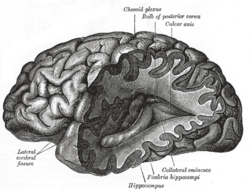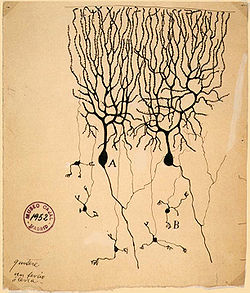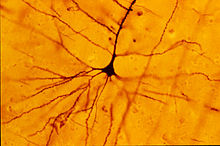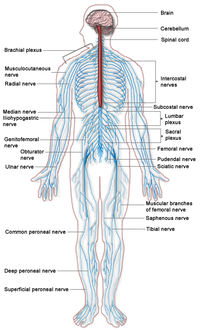- Neuroscience
-
Neuroscience is the scientific study of the nervous system.[1] Traditionally, neuroscience has been seen as a branch of biology. However, it is currently an interdisciplinary science that collaborates with other fields such as chemistry, computer science, engineering, linguistics, mathematics, medicine and allied disciplines, philosophy, physics, and psychology. The term neurobiology is usually used interchangeably with the term neuroscience, although the former refers specifically to the biology of the nervous system, whereas the latter refers to the entire science of the nervous system.
The scope of neuroscience has broadened to include different approaches used to study the molecular, cellular, developmental, structural, functional, evolutionary, computational, and medical aspects of the nervous system. The techniques used by neuroscientists have also expanded enormously, from molecular and cellular studies of individual nerve cells to imaging of sensory and motor tasks in the brain. Recent theoretical advances in neuroscience have also been aided by the study of neural networks.
Given the increasing number of scientists who study the nervous system, several prominent neuroscience organizations have been formed to provide a forum to all neuroscientists and educators. For example, the International Brain Research Organization was founded in 1960,[2] the International Society for Neurochemistry in 1963,[3] the European Brain and Behaviour Society in 1968,[4] and the Society for Neuroscience in 1969.[5]
Contents
History
See also: History of neuroscience Illustration from Gray's Anatomy (1918) of a lateral view of the human brain, featuring the hippocampus among other neuroanatomical features
Illustration from Gray's Anatomy (1918) of a lateral view of the human brain, featuring the hippocampus among other neuroanatomical features
The study of the nervous system dates back to ancient Egypt. Evidence of trepanation, the surgical practice of either drilling or scraping a hole into the skull with the purpose of curing headaches or mental disorders or relieving cranial pressure, being performed on patients dates back to Neolithic times and has been found in various cultures throughout the world. Manuscripts dating back to 1700 BC indicated that the Egyptians had some knowledge about symptoms of brain damage.[6]
Early views on the function of the brain regarded it to be a "cranial stuffing" of sorts. In Egypt, from the late Middle Kingdom onwards, the brain was regularly removed in preparation for mummification. It was believed at the time that the heart was the seat of intelligence. According to Herodotus, the first step of mummification is to "take a crooked piece of iron, and with it draw out the brain through the nostrils, thus getting rid of a portion, while the skull is cleared of the rest by rinsing with drugs."[7]
The view that the heart was the source of consciousness was not challenged until the time of Hippocrates. He believed that the brain was not only involved with sensation—since most specialized organs (e.g., eyes, ears, tongue) are located in the head near the brain—but was also the seat of intelligence. Plato also speculated that the brain was the seat of the rational part of the soul.[8] Aristotle, however, believed the heart was the center of intelligence and that the brain regulated the amount of heat from the heart.[9] This view was generally accepted until the Roman physician Galen, a follower of Hippocrates and physician to Roman gladiators, observed that his patients lost their mental faculties when they had sustained damage to their brains.
Abulcasis, Averroes, Avenzoar, and Maimonides, active in the Medieval Muslim world, described a number of medical problems related to the brain. In Renaissance Europe, Vesalius (1514–1564) and René Descartes (1596–1650) also made several contributions to neuroscience.
Studies of the brain became more sophisticated after the invention of the microscope and the development of a staining procedure by Camillo Golgi during the late 1890s. The procedure used a silver chromate salt to reveal the intricate structures of individual neurons. His technique was used by Santiago Ramón y Cajal and led to the formation of the neuron doctrine, the hypothesis that the functional unit of the brain is the neuron. Golgi and Ramón y Cajal shared the Nobel Prize in Physiology or Medicine in 1906 for their extensive observations, descriptions, and categorizations of neurons throughout the brain. The neuron doctrine was supported by experiments following Luigi Galvani's pioneering work in the electrical excitability of muscles and neurons. In the late 19th century, Emil du Bois-Reymond, Johannes Peter Müller, and Hermann von Helmholtz demonstrated that neurons were electrically excitable and that their activity predictably affected the electrical state of adjacent neurons.
In parallel with this research, work with brain-damaged patients by Paul Broca suggested that certain regions of the brain were responsible for certain functions. At the time, Broca's findings were seen as a confirmation of Franz Joseph Gall's theory that language was localized and that certain psychological functions were localized in specific areas of the cerebral cortex.[10][11] The localization of function hypothesis was supported by observations of epileptic patients conducted by John Hughlings Jackson, who correctly inferred the organization of the motor cortex by watching the progression of seizures through the body. Carl Wernicke further developed the theory of the specialization of specific brain structures in language comprehension and production. Modern research still uses the Brodmann cerebral cytoarchitectonic map (referring to study of cell structure) anatomical definitions from this era in continuing to show that distinct areas of the cortex are activated in the execution of specific tasks.[12]
In 1952, Alan Lloyd Hodgkin and Andrew Huxley presented a mathematical model for transmission of electrical signals in neurons of the giant axon of a squid, action potentials, and how they are initiated and propagated, known as the Hodgkin-Huxley model. In 1961-2, Richard FitzHugh and J. Nagumo simplified Hodgkin-Huxley, in what is called the FitzHugh–Nagumo model. In 1962, Bernard Katz modeled neurotransmission across the space between neurons known as synapses. In 1981 Catherine Morris and Harold Lecar combined these models in the Morris-Lecar model. In 1984, J. L. Hindmarsh and R.M. Rose further modeled neurotransmission.
Beginning in 1966, Eric Kandel and collaborators examined biochemical changes in neurons associated with learning and memory storage.
Modern Neuroscience
The scientific study of the nervous system has increased significantly during the second half of the twentieth century, principally due to advances in molecular biology, electrophysiology, and computational neuroscience. This has allowed neuroscientists to study the nervous system in all its aspects: how it is structured, how it works, how it develops, how it malfunctions, and how it can be changed. For example, it has become possible to understand, in much detail, the complex processes occurring within a single neuron. Neurons are cells specialized for communication. They are able to contact with neurons and other cell types through specialized junctions called synapses, at which electrical or electrochemical signals can be transmitted from one cell to another. Many neurons extrude long thin filaments of protoplasm called axons, which may extend to distant parts of the body and are capable of rapidly carrying electrical signals, influencing the activity of other neurons, muscles, or glands at their termination points. A nervous system emerges from the assemblage of neurons that are connected to each other.
In vertebrates, the nervous system can be split into two parts, the central nervous system (brain and spinal cord), and the peripheral nervous system. In many species — including all vertebrates — the nervous system is the most complex organ system in the body, with most of the complexity residing in the brain. The human brain alone contains around a hundred billion neurons and a hundred trillion synapses; it consists of thousands of distinguishable substructures, connected to each other in synaptic networks whose intricacies have only begun to be unraveled. The majority of genes belonging to the human genome are expressed specifically in the brain. Thus the challenge of making sense of all this complexity is formidable.
Molecular and cellular neuroscience
The study of the nervous system can be done at multiple levels, ranging from the molecular and cellular levels to the systems and cognitive levels. At the molecular level, the basic questions addressed in molecular neuroscience include the mechanisms by which neurons express and respond to molecular signals and how axons form complex connectivity patterns. At this level, tools from molecular biology and genetics are used to understand how neurons develop and how genetic changes affect biological functions. The morphology, molecular identity, and physiological characteristics of neurons and how they relate to different types of behavior are also of considerable interest.
At the cellular level, the fundamental questions addressed in cellular neuroscience include the mechanisms of how neurons process signals physiologically and electrochemically. They address how signals are processed by dendrites, somas and axons, and how neurotransmitters and electrical signals are used to process signals in a neuron.[clarification needed] Another major area of neuroscience is directed at investigations of the development of the nervous system. These questions include the patterning and regionalization of the nervous system, neural stem cells, differentiation of neurons and glia, neuronal migration, axonal and dendritic development, trophic interactions, and synapse formation.
Neural circuits and systems
At the systems level, the questions addressed in systems neuroscience include how neural circuits are formed and used anatomically and physiologically to produce functions such as reflexes, sensory integration, motor coordination, circadian rhythms, emotional responses, learning, and memory. In other words, they address how these neural circuits function and the mechanisms through which behaviors are generated. For example, systems level analysis addresses questions concerning specific sensory and motor modalities: how does vision work? How do songbirds learn new songs and bats localize with ultrasound? How does the somatosensory system process tactile information? The related fields of neuroethology and neuropsychology address the question of how neural substrates underlie specific animal and human behaviors. Neuroendocrinology and psychoneuroimmunology examine interactions between the nervous system and the endocrine and immune systems, respectively. Despite many advancements, the way networks of neurons produce complex cognitions and behaviors is still poorly understood.
Cognitive and behavioral neuroscience
At the cognitive level, cognitive neuroscience addresses the questions of how psychological functions are produced by neural circuitry. The emergence of powerful new measurement techniques such as neuroimaging (e.g., fMRI, PET, SPECT), electrophysiology, and human genetic analysis combined with sophisticated experimental techniques from cognitive psychology allows neuroscientists and psychologists to address abstract questions such as how human cognition and emotion are mapped to specific neural substrates.
Neuroscience is also allied with the social and behavioral sciences as well as nascent interdisciplinary fields such as neuroeconomics, decision theory, and social neuroscience to address complex questions about interactions of the brain with its environment.
Ultimately neuroscientists would like to understand every aspect of the nervous system, including how it works, how it develops, how it malfunctions, and how it can be altered or repaired. The specific topics that form the main foci of research change over time, driven by an ever-expanding base of knowledge and the availability of increasingly sophisticated technical methods. Over the long term, improvements in technology have been the primary drivers of progress. Developments in electron microscopy, computers, electronics, functional brain imaging, and most recently genetics and genomics, have all been major drivers of progress.
Translational research and medicine
Main article: Translational researchNeurology, psychiatry, neurosurgery, psychosurgery, neuropathology, neuroradiology, clinical neurophysiology and addiction medicine are medical specialties that specifically address the diseases of the nervous system. These terms also refer to clinical disciplines involving diagnosis and treatment of these diseases. Neurology works with diseases of the central and peripheral nervous systems, such as amyotrophic lateral sclerosis (ALS) and stroke, and their medical treatment. Psychiatry focuses on affective, behavioral, cognitive, and perceptual disorders. Neuropathology focuses upon the classification and underlying pathogenic mechanisms of central and peripheral nervous system and muscle diseases, with an emphasis on morphologic, microscopic, and chemically observable alterations. Neurosurgery and psychosurgery work primarily with surgical treatment of diseases of the central and peripheral nervous systems. The boundaries between these specialties have been blurring recently as they are all influenced by basic research in neuroscience. Brain imaging also enables objective, biological insights into mental illness, which can lead to faster diagnosis, more accurate prognosis, and help assess patient progress over time.[13]
Integrative neuroscience makes connections across these specialized areas of focus.
Major branches
Modern neuroscience education and research activities can be very roughly categorized into the following major branches, based on the subject and scale of the system in examination as well as distinct experimental or curricular approaches. Individual neuroscientists, however, often work on questions that span several distinct subfields.
Branch Description Affective neuroscience Affective neuroscience is the study of the neural mechanisms involved in emotion, typically through experimentation on animal models.[14] Behavioral neuroscience Behavioral neuroscience (also known as biological psychology, biopsychology, or psychobiology) is the application of the principles of biology (viz., neurobiology) to the study of genetic, physiological, and developmental mechanisms of behavior in humans and non-human animals. Cellular neuroscience Cellular neuroscience is the study of neurons at a cellular level including morphology and physiological properties. Clinical neuroscience This consists of medical specialties such as neurology and psychiatry, as well as many allied health professions such as speech-language pathology. Neurology is the medical specialty that works with disorders of the nervous system. Psychiatry is the medical specialty that works with the disorders of the mind—which include various affective, behavioral, cognitive, and perceptual disorders. (Also see note below.) Cognitive neuroscience Cognitive neuroscience is the study of biological substrates underlying cognition with a specific focus on the neural substrates of mental processes. Computational neuroscience Computational neuroscience is the study of brain function in terms of the information processing properties of the structures that make up the nervous system. Computational neuroscience can also refer to the use of computer simulations and theoretical models to study the function of the nervous system. Cultural neuroscience Cultural neuroscience is the study of how cultural values, practices and beliefs shape and are shaped by the mind, brain and genes across multiple timescales.[15] Developmental neuroscience Developmental neuroscience studies the processes that generate, shape, and reshape the nervous system and seeks to describe the cellular basis of neural development to address underlying mechanisms. Molecular neuroscience Molecular neuroscience is a branch of neuroscience that examines the biology of the nervous system with molecular biology, molecular genetics, protein chemistry, and related methodologies. Neuroengineering Neuroengineering is a discipline within biomedical engineering that uses engineering techniques to understand, repair, replace, or enhance neural systems. Neuroimaging Neuroimaging includes the use of various techniques to either directly or indirectly image the structure and function of the brain. Neuroinformatics Neuroinformatics is a discipline within bioinformatics that conducts the organization of neuroscience data and application of computational models and analytical tools. Neurolinguistics Neurolinguistics is the study of the neural mechanisms in the human brain that control the comprehension, production, and acquisition of language. Neurophysiology Neurophysiology is the study of the functioning of the nervous system, generally using physiological techniques that include measurement and stimulation with electrodes or optically with ion- or voltage-sensitive dyes or light-sensitive channels. Social neuroscience Social neuroscience is an interdisciplinary field devoted to understanding how biological systems implement social processes and behavior, and to using biological concepts and methods to inform and refine theories of social processes and behavior. Systems neuroscience Systems neuroscience is the study the function of neural circuits and systems. Neuroscience organizations
The largest professional neuroscience organization is the Society for Neuroscience (SFN), which is based in the United States but includes many members from other countries. Since its founding in 1969 the SFN has grown steadily: as of 2010 it recorded 40,290 members from 83 different countries.[16] Annual meetings, held each year in a different American city, draw attendance from researchers, postdoctoral fellows, graduate students, and undergraduates, as well as educational institutions, funding agencies, publishers, and hundreds of businesses that supply products used in research.
Other major organizations devoted to neuroscience include the International Brain Research Organization (IBRO), which holds its annual meetings in a country from a different part of the world each year, and the Federation of European Neuroscience Societies (FENS), which holds annual meetings in European cities. FENS comprises a set of 32 national-level organizations, including the British Neuroscience Association, the German Neurowissenschaftliche Gesellschaft, and the French Societé des Neurosciences.
Public education and outreach
In addition to conducting traditional research in laboratory settings, neuroscientists have also been involved in the promotion of awareness and knowledge about the nervous system among the general public and government officials. Such promotions have been done by both individual neuroscientists and large organizations. For example, individual neuroscientists have promoted neuroscience education among young students by organizing the International Brain Bee (IBB), which is an academic competition for high school or secondary school students worldwide.[17] In the United States, large organizations such as the Society for Neuroscience have promoted neuroscience education by developing a primer called Brain Facts,[18] collaborating with public school teachers to develop Neuroscience Core Concepts for K-12 teachers and students,[19] and cosponsoring a campaign with the Dana Foundation called Brain Awareness Week to increase public awareness about the progress and benefits of brain research.[20]
Finally, neuroscientists have also collaborated with other education experts to study and refine educational techniques to optimize learning among students, an emerging field called educational neuroscience.[21] Federal agencies in the United States, such as the National Institute of Health (NIH)[22] and National Science Foundation (NSF),[23] have also funded research that pertains to best practices in teaching and learning of neuroscience concepts.
See also
- List of neuroscience databases
- List of neuroscience topics
- List of neuroscientists
References
- ^ "Neuroscience". Merriam-Webster Medical Dictionary. http://www.merriam-webster.com/medlineplus/neuroscience.
- ^ "History of IBRO". International Brain Research Organization. 2010. http://www.ibro.info/Pub/Pub_Main_Display.asp?LC_Docs_ID=2343.
- ^ The Beginning, International Society for Neurochemistry
- ^ "About EBBS". European Brain and Behaviour Society. 2009. http://www.ebbs-science.org/cms/general/about-ebbs.html.
- ^ "About SfN". Society for Neuroscience. http://www.sfn.org/index.aspx?pagename=about_sfn.
- ^ Mohamed W (2008). "The Edwin Smith Surgical Papyrus: Neuroscience in Ancient Egypt". IBRO History of Neuroscience. http://www.ibro.info/Pub/Pub_Main_Display.asp?LC_Docs_ID=3199.
- ^ Herodotus (440BCE). The Histories: Book II (Euterpe). http://classics.mit.edu/Herodotus/history.mb.txt.
- ^ Plato (360BCE). Timaeus. http://classics.mit.edu/Plato/timaeus.1b.txt.
- ^ Finger, Stanley (2001). Origins of Neuroscience: A History of Explorations into Brain Function (3rd ed.). New York: Oxford University Press, USA. pp. 3–17. ISBN 0-195-14694-8.
- ^ Greenblatt SH (1995). "Phrenology in the science and culture of the 19th century". Neurosurg 37 (4): 790–805. doi:10.1227/00006123-199510000-00025. PMID 8559310. http://journals.lww.com/neurosurgery/Abstract/1995/10000/Phrenology_in_the_Science_and_Culture_of_the_19th.25.aspx.
- ^ Bear MF, Connors BW, Paradiso MA (2001). Neuroscience: Exploring the Brain (4th ed.). Philedelphia, PA: Lippincott Williams & Wilkins. ISBN 0781739446.
- ^ Kandel ER, Schwartz JH, Jessel TM (2000). Principles of Neural Science (4th ed.). New York, NY: McGraw-Hill. ISBN 0838577016.
- ^ Lepage M (2010). "Research at the Brain Imaging Centre". Douglas Mental Health University Institute. http://www.douglas.qc.ca/page/imagerie-cerebrale?locale=en.
- ^ Panksepp J (1990). "A role for "affective neuroscience" in understanding stress: the case of separation distress circuitry". In Puglisi-Allegra S, Oliverio A. Psychobiology of Stress. Dordrecht, Netherlands: Kluwer Academic. pp. 41–58. ISBN 0792306821.
- ^ Chiao, J.Y. & Ambady, N. (2007). Cultural neuroscience: Parsing universality and diversity across levels of analysis. In Kitayama, S. and Cohen, D. (Eds.) Handbook of Cultural Psychology, Guilford Press, NY, pp. 237-254.
- ^ "Financial and organizational highlights". Society for Neuroscience. http://www.sfn.org/skins/main/pdf/annual_report/fy2010/highlights.pdf.
- ^ "About the International Brain Bee". The International Brain Bee. http://www.internationalbrainbee.com/about_bee.html.
- ^ "Brain Facts: A Primer on the Brain and Nervous System". Society for Neuroscience. http://www.sfn.org/index.aspx?pagename=brainfacts.
- ^ "Neuroscience Core Concepts: The Essential Principles of Neuroscience". Society for Neuroscience. http://www.sfn.org/index.aspx?pagename=core_concepts.
- ^ "Brain Awareness Week Campaign". The Dana Foundation. http://www.dana.org/brainweek/.
- ^ Goswami U (2004). "Neuroscience, education and special education". Br J of Spec Educ 31 (4): 175–183. doi:10.1111/j.0952-3383.2004.00352.x.
- ^ "The SEPA Program". NIH. http://www.ncrrsepa.org/. Retrieved September 23, 2011.
- ^ "About Education and Human Resources". NSF. http://www.nsf.gov/ehr/about.jsp. Retrieved September 23, 2011.
Further reading
- Bear, M. F.; B. W. Connors, and M. A. Paradiso (2006). Neuroscience: Exploring the Brain (3rd ed.). Philadelphia: Lippincott. ISBN 0781760038.
- Binder/Hirokawa/Windhorst (2009, 4399pp, 5 vols). Encyclopedia of Neuroscience. Springer. ISBN 978-3-540-23735-8. http://www.springer.com/biomed/neuroscience/book/978-3-540-23735-8.
- Kandel, ER; Schwartz JH, Jessell TM (2000). Principles of Neural Science (4th ed.). New York: McGraw-Hill. ISBN 0-8385-7701-6.
- Squire, L. et al. (2003). Fundamental Neuroscience, 2nd edition. Academic Press; ISBN 0-12-660303-0
- Byrne and Roberts (2004). From Molecules to Networks. Academic Press; ISBN 0-12-148660-5
- Sanes, Reh, Harris (2005). Development of the Nervous System, 2nd edition. Academic Press; ISBN 0-12-618621-9
- Siegel et al. (2005). Basic Neurochemistry, 7th edition. Academic Press; ISBN 0-12-088397-X
- Rieke, F. et al. (1999). Spikes: Exploring the Neural Code. The MIT Press; Reprint edition ISBN 0-262-68108-0
- section.47 Neuroscience 2nd ed. Dale Purves, George J. Augustine, David Fitzpatrick, Lawrence C. Katz, Anthony-Samuel LaMantia, James O. McNamara, S. Mark Williams. Published by Sinauer Associates, Inc., 2001.
- section.18 Basic Neurochemistry: Molecular, Cellular, and Medical Aspects 6th ed. by George J. Siegel, Bernard W. Agranoff, R. Wayne Albers, Stephen K. Fisher, Michael D. Uhler, editors. Published by Lippincott, Williams & Wilkins, 1999.
- Andreasen, Nancy C. (March 4 2004). Brave New Brain: Conquering Mental Illness in the Era of the Genome. Oxford University Press. ISBN 9780195145090. http://www.oup.com/uk/catalogue/?ci=9780195145090.
- Damasio, A. R. (1994). Descartes' Error: Emotion, Reason, and the Human Brain. New York, Avon Books. ISBN 0-399-13894-3 (Hardcover) ISBN 0-380-72647-5 (Paperback)
- Gardner, H. (1976). The Shattered Mind: The Person After Brain Damage. New York, Vintage Books, 1976 ISBN 0-394-71946-8
- Goldstein, K. (2000). The Organism. New York, Zone Books. ISBN 0-942299-96-5 (Hardcover) ISBN 0-942299-97-3 (Paperback)
- Lauwereyns, Jan (February 2010). The Anatomy of Bias: How Neural Circuits Weigh the Options. Cambridge, MA: The MIT Press. ISBN 026212310X. http://mitpress.mit.edu/9780262123105.
- Llinas R. (2001). I of the Vortex: From Neurons to Self MIT Press. ISBN 0-262-12233-2 (Hardcover) ISBN 0-262-62163-0 (Paperback)
- Luria, A. R. (1997). The Man with a Shattered World: The History of a Brain Wound. Cambridge, Massachusetts, Harvard University Press. ISBN 0-224-00792-0 (Hardcover) ISBN 0-674-54625-3 (Paperback)
- Luria, A. R. (1998). The Mind of a Mnemonist: A Little Book About A Vast Memory. New York, Basic Books, Inc. ISBN 0-674-57622-5
- Medina, J. (2008). Brain Rules: 12 Principles for Surviving and Thriving at Work, Home, and School. Seattle, Pear Press. ISBN 0-979-777704 (Hardcover with DVD)
- Pinker, S. (1999). How the Mind Works. W. W. Norton & Company. ISBN 0-393-31848-6
- Pinker, S. (2002). The Blank Slate: The Modern Denial of Human Nature. Viking Adult. ISBN 0-670-03151-8
- Robinson, D. L. (2009). Brain, Mind and Behaviour: A New Perspective on Human Nature (2nd ed.). Dundalk, Ireland: Pontoon Publications. ISBN 978-0-9561812-0-6.
- Ramachandran, V. S. (1998). Phantoms in the Brain. New York, New York Harper Collins. ISBN 0-688-15247-3 (Paperback)
- Rose, S. (2006). 21st Century Brain: Explaining, Mending & Manipulating the Mind ISBN 0099429772 (Paperback)
- Sacks, O. The Man Who Mistook His Wife for a Hat. Summit Books ISBN 0-671-55471-9 (Hardcover) ISBN 0-06-097079-0 (Paperback)
- Sacks, O. (1990). Awakenings. New York, Vintage Books. (See also Oliver Sacks) ISBN 0-671-64834-9 (Hardcover) ISBN 0-06-097368-4 (Paperback)
- Sternberg, E. (2007) Are You a Machine? The Brain, the Mind and What it Means to be Human. Amherst, NY: Prometheus Books.
- Churchland, P. S. (2011) Braintrust: What Neuroscience Tells Us about Morality. Princeton University Press. ISBN 0-69-113703-X
External links
- Neuroscience on In Our Time at the BBC. (listen now)
- Neuroscience Information Framework (NIF)
- Neurobiology at the Open Directory Project
- American Society for Neurochemistry
- Neuroscience Online (electronic neuroscience textbook)
- Faculty for Undergraduate Neuroscience (FUN)
- Neuroscience for Kids
- Neuroscience Discussion Group in ResearchGate
- Neuroscience Discussion Forum
- HHMI Neuroscience lecture series - Making Your Mind: Molecules, Motion, and Memory
Categories:- Neuroscience
- Interdisciplinary fields
- Biology
Wikimedia Foundation. 2010.





